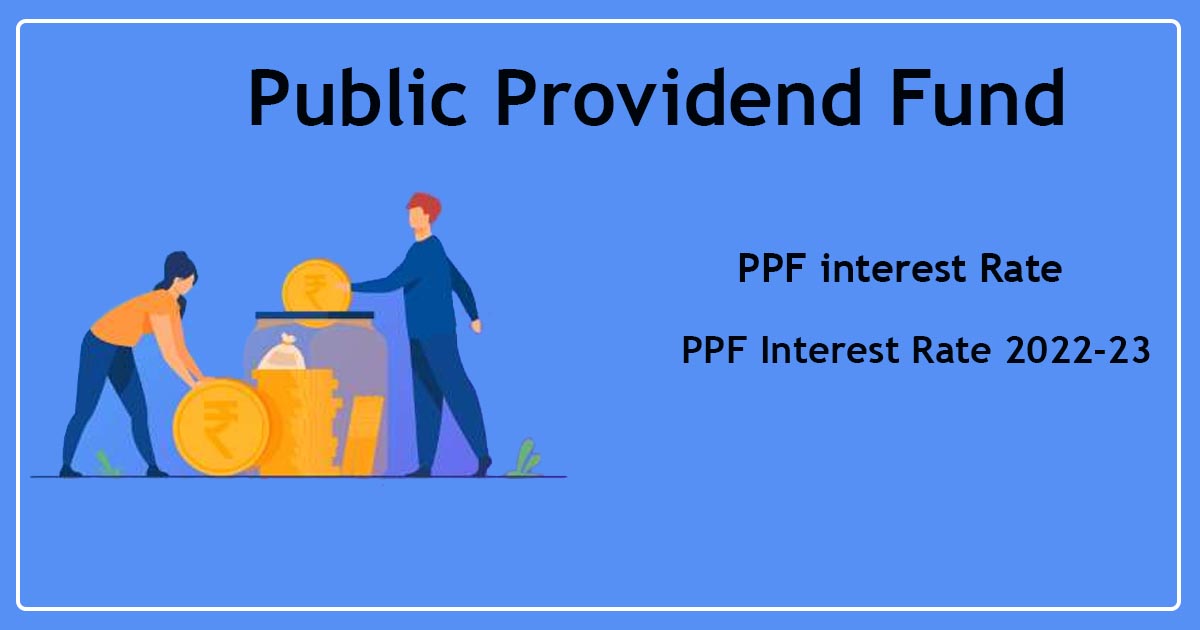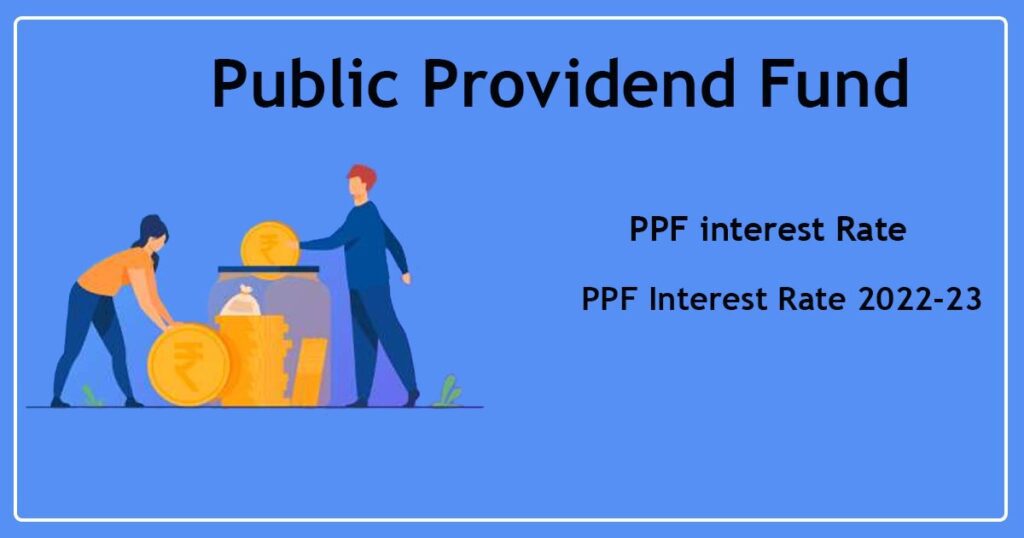
PPF Interest Rate
The Public Provident Fund is known as PPF. It was first introduced in 1968 with the intention of converting small savings into investments offering reasonable returns and additional advantages for tax reduction. It helps create a retirement fund. The current annual compound PPF interest rate is 7.1%. PPF is supported by the Indian government, carries very little risk, and promises risk-free returns.
It qualifies for EEE status, which means that all of the invested money, interest that is earned, and maturity money that is received are tax-free.
PPF also has a minimum term of 15 years and an unlimited number of five-year extensions. Additionally, a PPF account can hold a minimum investment of 500 and a maximum of 1,50,000.
Additionally, it can be paid in a single payment or a maximum of 12 installments. A minimum of once per year must be deposited into a PPF account.
Important PPF Features
Tenure: It has a 15-year minimum term that can be increased in 5-year increments.
PPF Limit: PPF permits a minimum investment of Rs. 500 and a maximum investment of Rs. 15 lakhs per fiscal year.
Deposit frequency: Throughout the tenure, deposits must be made at least once a year.
Deposit mode: You can make deposits to a PPF account with cash, checks, demand draughts, and online fund transfers.
Nominee: Account holders have the option to name a nominee for their accounts either at account opening or at a later time.
Joint account: The account can be in the name of one individual only.
Risk: The government’s backing means that the scheme offers a guaranteed and risk-free return.
PPF Interest Rate 2022-23
Here is a chart showing the evolution of PPF account interest rates over the last ten years to the current PPF interest rate.
| PPF Interest Rates April 2023 | ||
| Financial Year | Time Period | PPF Interest Rate (per annum) |
| 2022-2023 | April 2022 – March 2023 | 7.10% |
| 2021-2022 | April 2021 – March 2022 | 7.10% |
| 2020-2021 | April 2020 – March 2021 | 7.10% |
| 2020-2021 | January 2020 – March 2020 | 7.90% |
| 2019-2020 | October 2019 – December 2019 | 7.90% |
| 2019-2020 | July 2019 – September 2019 | 7.90% |
| 2019-2020 | April 2019 – June 2019 | 8.00% |
| 2018-2019 | January 2019 – March 2019 | 8.00% |
| 2018-2019 | October 2018 – December 2018 | 8.00% |
| 2018-2019 | July 2018 – September 2018 | 8.00% |
| 2018-2019 | April 2018 – June 2018 | 7.60% |
| 2017-2018 | January 2018 – March 2018 | 7.60% |
| 2017-2018 | October 2017 – December 2017 | 7.80% |
| 2017-2018 | July 2017 – September 2017 | 7.80% |
| 2017-2018 | April 2017 – June 2017 | 7.90% |
| 2015-2016 | April 2015 – March 2016 | 8.70% |
| 2014-2015 | April 2014 – March 2015 | 8.70% |
| 2013-2014 | April 2013 – March 2014 | 8.70% |
| 2012-2013 | April 2012 – March 2013 | 8.80% |
| 2011-2012 | April 2011 – November 2011 | 8.00% |
| 2011-2012 | December 2011 – March 2012 | 8.60% |
| 2010-2011 | April 2010 – March 2011 | 8.00% |
| 2009-2010 | April 2009 – March 2010 | 8.00% |
| 2008-2009 | April 2008 – March 2009 | 8.00% |
| 2007-2008 | April 2007 – March 2008 | 8.00% |
| 2006-2007 | April 2006 – March 2007 | 8.00% |
| 2005-2006 | April 2005 – March 2006 | 8.00% |
| 2004-2005 | April 2004 – March 2005 | 8.00% |
Opening a PPF account
Creating a PPF account is simple. All that is required is the submission of an application form along with documentation of KYC, address, identity, and signature.
You can open a PPF account at the Post Office or any other nationalised bank. A few private banks are also permitted to assist with PPF account opening. PPF investments is locked in for 15 years.
After completing six years, there is an option to withdraw money beginning in the seventh year. The amount is available for withdrawal once per year.
Minimum tenture
PPF has a 15-year minimum term that can be increased indefinitely in 5-year increments. Additionally, the minimum and maximum investments in PPF accounts are 500 and 1,50,000 rupees, respectively.
Investments may be made in a single payment or up to 12 installments. PPF accounts require deposits to be made at least once per year for 15 years.
How the PPF Calculator Works
The mathematical formula used by a PPF calculator to determine returns and interest earned on an investment. Their use is very simple. The majority of calculators have a simple user interface.
Here is a brief, step-by-step tutorial on how to use a PPF interest calculator if you are new to using online calculators:
1: Visit the website of your choice for an online PPF calculator.
2: Include your initial investment amount and interest rate in the list of requested information.
3: Within a few seconds, the total maturity amount will be visible on the screen.
It should be noted that if a deposit is made on April 1, the financial year will be used to determine how much interest is earned.
How is the PPF interest rate calculated?
PPF interest is compounded annually.
The formula for this is F=P[({(1+i)^n}-1)/i]
The explanation of the formula is:
F = Maturity Proceeds of the PPF
P = Annual Installments
n = Number of Years
i = rate of interest/100
How Can the PPF Calculator Be Useful?
Using online calculators can give you a clear understanding of the various investment options if you are new to investing. In the case of PPF, using an online PPF calculator can be a very beneficial investment option if you are new to investing.
Also see that exactly how your PPF investment is growing and how much interest you will eventually earn. You can determine how much you should invest annually or monthly using a PPF calculator to reach your desired corpus.
You can use a PPF calculator without installing any additional software multiple times for free.
The possibility of calculation errors is eliminated because this tool is automated. The majority of PPF calculators display the results graphically, making the information simple to comprehend for all users.
PPF Investment Schedule
Let’s use the PPF investment schedule as an example to help us better understand the overall concept. Consider an investor who makes annual investments of Rs. 1.1 lakh, takes out a PPF loan, and then withdraws the maximum amount allowed.
It is assumed that the interest rate will be 7.10%. The table below explains compounding, the opening balance, the impact of loans and withdrawals on PPF accounts, as well as the maturity value.
| Years | Opening Balance | Amount Deposited | Interest Earned | Closing Balance |
| 1 | 0 | 1,10,000 | 7810 | 1,17,810 |
| 2 | 1,18,690 | 1,10,000 | 16236.99 | 2,44,927 |
| 3 | 2,46,757 | 1,10,000 | 25329.747 | 3,82,087 |
| 4 | 3,84,941 | 1,10,000 | 35140.811 | 5,30,082 |
| 5 | 5,34,041 | 1,10,000 | 45726.911 | 6,89,768 |
| 6 | 6,94,920 | 1,10,000 | 57149.32 | 8,62,069 |
| 7 | 8,68,509 | 1,10,000 | 69474.139 | 10,47,983 |
| 8 | 10,55,811 | 1,10,000 | 82772.581 | 12,48,584 |
| 9 | 12,57,910 | 1,10,000 | 97121.61 | 14,65,032 |
| 10 | 14,75,975 | 1,10,000 | 112604.225 | 16,98,579 |
| 11 | 17,11,267 | 1,10,000 | 129309.957 | 19,50,577 |
| 12 | 19,65,147 | 1,10,000 | 147335.437 | 22,22,482 |
| 13 | 22,39,084 | 1,10,000 | 166784.964 | 25,15,869 |
| 14 | 25,34,662 | 1,10,000 | 187771.002 | 28,32,433 |
| 15 | 28,53,590 | 1,10,000 | 210414.89 | 31,74,005 |
Advantages of Using the PPF Calculator
A PPF account calculator is a straightforward and user-friendly online tool. For a given amount invested and investment period, a PPF calculator estimates the interest earned and the maturity value.
By visiting our website and entering the investment amount and time period, an investor can use the PPF calculator. The total corpus created at the conclusion of the investment period will be shown by the PPF maturity calculator.
Knowing the anticipated maturity amount in advance is crucial today. This aids a potential investor in selecting the PPF alternative that best suits his or her financial objectives.
The advantages of online PPF account calculator
An investor can estimate how much interest will be earned on a certain amount of principal by using an online PPF interest calculator.
It aids an investor in determining the investment horizon, or the length of time the investment should be held before it achieves the investment objective.
online PPF maturity calculator offers the investment schedule in advance, which led in planning for annual investment amount, loan that may be taken out, and amount that may be withdrawn.
Which banks provide PPF accounts?
Many public banks, private banks, post offices are offer PPF accounts, with online and offline both are available. The PPF account option is offered by the following banks.
| Bank | Online facility available | Type of bank |
| State Bank of India | Yes | Public Sector |
| ICICI Bank | Yes | Private Sector |
| HDFC Bank | Yes | Private Sector |
| Central Bank of India | Yes | Public Sector |
| Bank of India (BOI) | Yes | Public Sector |
| Union Bank of India | No | Public Sector |
| Bank of Maharashtra | No | Public Sector |
| IDBI | Yes | Public Sector |
| Bank of Baroda (BOB) | No | Public Sector |
| Vijaya Bank | No | Public Sector |
| Allahabad Bank | Yes | Public Sector |
| Oriental Bank of Commerce(OBC) | No | Public Sector |
| Canara Bank | Yes | Public Sector |
| Corporation Bank | No | Public Sector |
| Dena Bank | No | Public Sector |
| Indian Bank | No | Public Sector |
| Axis Bank | Yes | Private Sector |
| Indian Overseas Bank (IOB) | No | Public Sector |
| Punjab National Bank (PNB) | No | Public Sector |
| United Bank of India | No | Public Sector |
| Syndicate Bank | No | Public Sector |
| Andhra Bank | No | Public Sector |
| UCO Bank | No | Public Sector |
ELSS Vs PPF
Government guarantees cover PPF returns. PPF offered 12% annual returns when it first came out. PPF returns are currently 7.1%. Even with guaranteed returns, relying solely on PPF as a source of investment income is risky because inflation will eat away at the returns.
PPF may be the best choice for investors who are risk averse and seeking tax savings. But there are undoubtedly other options to consider for risk-takers. The most effective of them is the ELSS fund, a tax-saving investment choice.
There are no guaranteed returns from ELSS funds because their returns are market-linked. However, historically, average ELSS funds have produced positive long-term returns of around 14%, while the top ones have contributed 20%! If invested in ELSS for 7–10 years, one can anticipate returns of 12–14%.
What are alternatives of PPF?
Among the many tax-saving investments, PPF is a common choice. Before choosing an investment, an investor must consider the PPF scheme’s alternatives.
This choice must be based on what is best for his or her financial objectives, which may be either long-term, such as 15 years, or short-term, such as 5 years, for a specified lock-in period and expected returns.







